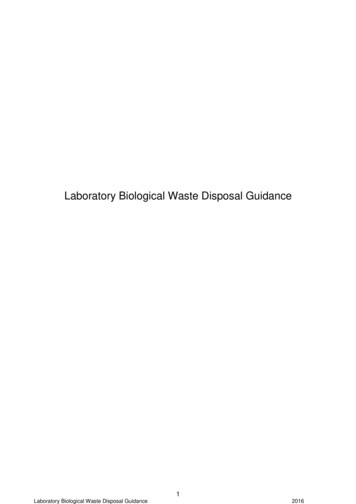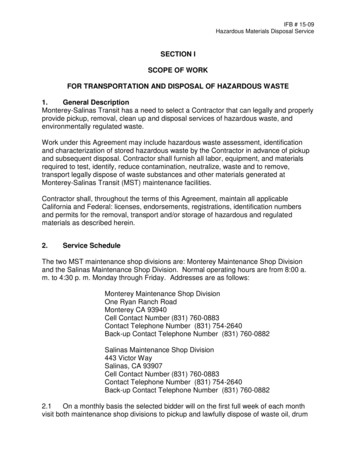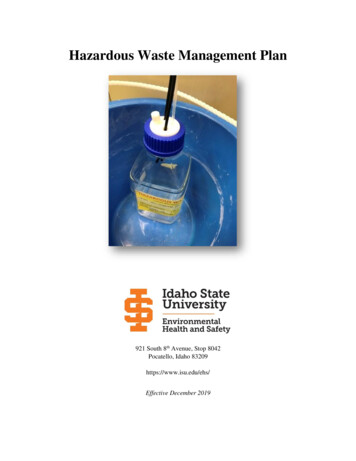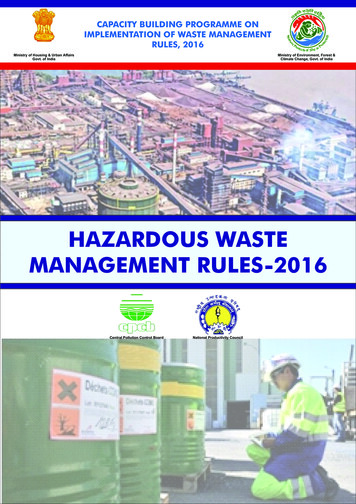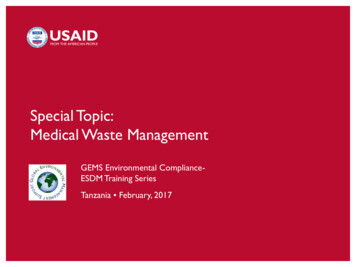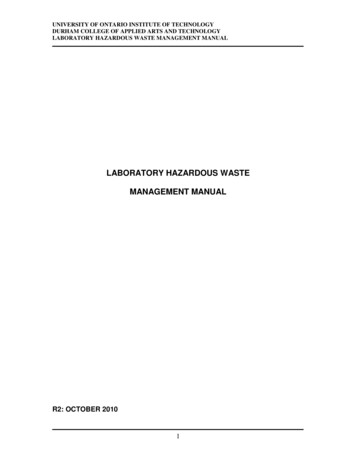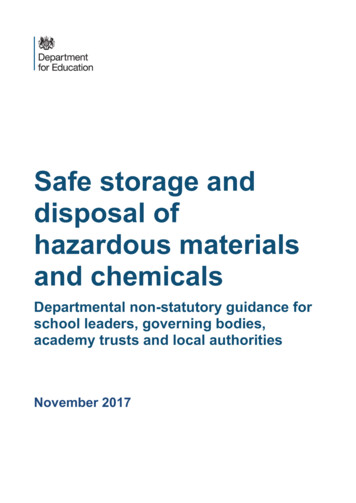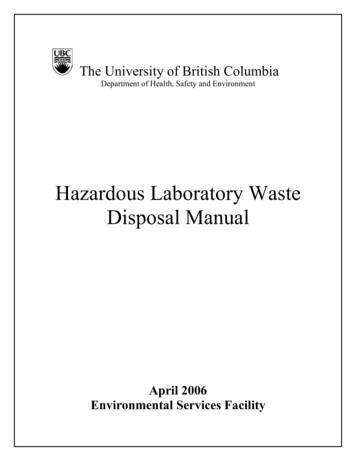
Transcription
The University of British ColumbiaDepartment of Health, Safety and EnvironmentHazardous Laboratory WasteDisposal ManualApril 2006Environmental Services Facility
Table of ContentsIntroduction. 1Disclaimer. 1Health, Safety and Environment Contacts. 2Environmental Services Facility . 2Permissible Generators. 2Acceptable Waste Types . 3General Waste Procedures . 3Solvent Recovery. 4Hazardous Waste Pickup. 4Special Note to Non-Core UBC Waste Generators . 4Price List for Non-Core UBC Waste Generators. 5Emergency Information. 7Emergency Numbers . 7Emergency Preparedness. 8Evacuation. 8Emergency Response Procedures . 9Fire . 9Earthquake . 9Hazardous Material Spills . 10First Aid Emergency. 10Bomb Threat . 10Frequently Asked Questions . 11Hazardous Laboratory Waste Disposal ProceduresBiohazardous Waste Disposal .1 – 1 to 1 – 5Radioactive Waste Disposal. .2 – 1 to 2 – 7Disposal Of Laboratory Chemicals .3 – 1 to 3 – 2Ethidium Bromide Waste Disposal .4 – 1 to 4 – 3Organic Solvent Recovery and Disposal .5 – 1 to 5 – 2Photochemical Wastes Disposal . .6 – 1Waste Battery Disposal . . 7 – 1 to 7 – 2Waste Oil Disposal .8 – 1 to 8 – 2Disposal Of Unknown Chemicals . .9 – 1
Disposal Of Explosive Chemicals . .10 – 1Polychlorinated Biphenyls Disposal . 11 – 1 to 1 – 2Biomedical Waste Disposal . .12 – 1 to 12 – 2Primate Anatomical Waste Disposal . .13 – 1Glass Waste Disposal . . 14 – 1 to 14 – 2Sharps and Needle Waste Disposal .15 – 1 to 15 – 3Propane and Butane Cylinder Disposal . .16 – 1 to 16 – 2Non-Indigenous Species Disposal 17 – 1 to 17 – 2Waste Mercury Disposal . 18 – 1 to 18 – 2AppendicesAppendix A: Biological Waste Disposal Tag (Red)Appendix B: UBC Biological Waste Disposal – PosterAppendix C: Chemical Waste Inventory FormAppendix D: Solvent – Recovery Tag (Green)Appendix E: Flammable Liquid Disposal Tag (Blue)Appendix F: Photographic Waste Tag (Purple)Appendix G: Exit Protocol for UBC Principal InvestigatorsAppendix H: Isotope Inventory Control SheetAppendix I: Low Activity Waste for Decay FormAppendix J: Environmental Reporting Procedures2
IntroductionThis manual has been prepared by the UBC Department of Health, Safetyand Environment (HSE) to provide information on the proper methods forthe disposal of hazardous waste. Improper disposal of hazardous wastes canbe harmful to the environment and humans. The disposal of hazardouswaste is also governed by strict local, provincial, and federal regulations. Itis important to follow the procedures as stated in order to avoid legalrepercussions.This manual and its Hazardous Laboratory Waste Disposal Procedures canalso be downloaded from the HSE website (www.hse.ubc.ca). The manualand procedures can be found under the “Procedures” link. (Note: AdobeReader will be required.)HSE operates the Environmental Services Facility (ESF) which manages andhandles the hazardous waste generated by UBC core research, education andoperational activities. The facility will safely manage hazardous waste inaccordance with local, provincial and federal regulations. For moreinformation, please contact the Environmental Programs Officer (EPO) at(604) 822-9280.DisclaimerThis manual is intended for use by those who produce hazardous waste as aresult of their work at the University of British Columbia. The materialcontained in this manual is correct to the best of knowledge of the UBCDepartment of Health, Safety and Environment. The disposal procedures arecompliant with applicable local, provincial and federal legislation.Updates to procedures are made occasionally. If you have procedures olderthan two years, please check with HSE for the most current update.1
Health, Safety and Environment ContactsEdward LeeEnvironmental Programs Officer(604) 822-9280Bang DangTechnician, Environmental Services Facility(604) 822-1285Ivan LeversageTechnician, Environmental Services Facility(604) 822-6306John El-Baghdady Technician, Environmental Services Facility(604) 827-5389Andy TrinhTechnician, Environmental Services Facility(604) 822-1281Bruce AndersonBiosafety Officer(604) 822-7596Donna AshickEnvironmental Audit Officer(604) 822-8762David BellOccupational Hygiene Officer(604) 822-2643Ted SedgwickRadiation Safety Officer(604) 822-7052Environmental Services FacilityIMPORTANT NOTE: There are some wastes that are outside of ESF’smandate or cannot be accepted because of the restrictions in its operatingpermit. The cost of disposal for these wastes must be borne by thegenerator.ESF cannot manage or handle the following, and therefore, this proceduredoes not include:§ Unknown solid or liquid chemicals (please refer to “Disposal ofUnknown Chemicals” procedure 06.01.09.R02, May 2005, for furtherinstructions);§ Toxic gases;§ Explosives; and,§ Radioactive chemicals (please refer to “Radioactive Solid WasteDisposal” procedure 06.01.02.R03, May 2005 for further instructionsPermissible GeneratorsThe ESF can only handle and manage wastes which originate only fromgenerators and independent companies affiliated with UBC activities.All waste generators are required to apply to the ESF for its official wastegenerator status. Approved waste generators will be assigned a wastegenerator number that is to be associated with all shipments of wasteoriginating from their respective sections.2
Acceptable Waste TypesGeneral waste classifications permitted at the facility are as follows:Class 2 – GasesClass 2.1 – Flammable GasClass 3 – Flammable and Combustible LiquidsClass 4Class 4.1 – Flammable SolidClass 4.2 – Spontaneously CombustibleClass 4.3 – Dangerous When WetClass 5 – Oxidizing SubstancesClass 5.1 – OxidizerClass 5.2 – Organic PeroxideClass 6 – Poisonous (toxic) substances and infectious substancesClass 6.1 – ToxicClass 6.2 – InfectiousClass 8 – Corrosive substancesClass 9 – Miscellaneous productsGeneral Waste ProceduresAll wastes sent to the facility must be accompanied by waste identificationinformation. If you have any questions, please contact an ESF Technician at822-1285 or 822-6306.a. Flammable Liquids: All movement of solvent wastes must beaccompanied by serialized Flammable Liquids Disposal tag attachedto each container. The generator barcode sticker must be affixed tothe tag and the waste composition completed.b. Waste Chemicals: All shipments of chemical wastes must beaccompanied by a completed Chemical Waste Inventory Form. Thisinventory must identify the generator, their location, phone numberand the chemicals to be disposed.c. Biohazardous Waste: All movement of biological materials must beaccompanied by a serialized Biological Waste Disposal tag attachedto each bag. The generator barcode sticker must be affixed to the tagand the waste composition completed.d. Radioactive Waste: All radioactive material must be accounted for onan approved inventory form that can be acquired from the UBCRadiation Safety Office (RSO). The disposal option is determined bythe radioisotope activity.3
Solvent RecoverySolvent wastes that are acceptable at the facility for recovery include:xylene, methanol, and acetone. Prior to waste solvents being sent forrecovery, segregation procedures must be set up with the solvent recoverytechnician to ensure waste streams are compatible for recovery. Contact theESF Technician ((604) 822-1285) for more information.Hazardous Waste PickupESF picks up hazardous waste throughout UBC on a scheduled basis.Pickups are scheduled Monday to Thursday. Each building has a designatedarea for hazardous waste storage and pickup location. These areas should besecure (such as locked rooms or cages).Most buildings are on a schedule for routine collection. If you are unsure asto whether your building is on this schedule or if you require special pickup, contact the Environmental Services Facility at (604) 822-1285, (604)822-6306 or (604) 827-5389.Special Note to Non-Core UBC Waste GeneratorsEnvironmental Services Facility (ESF) also offers these disposal services towaste generators that are not UBC departments or faculties, but who arelocated on the Point Grey Campus, or are tenants of UBC property.Hazardous waste disposal for non-UBC waste generators will be charged asper the prices on the following page. The invoice will also include a chargefor transportation, chemist and manifest. For an accurate quote, a completechemical inventory must be faxed to ESF. Due to the nature of theenvironmental services industry and factors beyond our control, prices maybe subject to change without notice.For more information on the disposal, recycling, treatment or exchange ofyour biohazardous, biomedical and hazardous waste, please contact an ESFTechnician at (604) 822-1285 or (604) 822-6306 at the EnvironmentalServices Facility.4
UBC Environmental Services FacilityPrice List for Non-Core UBC Waste Generators(Effective: May 2005)Hazardous Waste DisposalClass 1 – ExplosivesClass 2 – GasesClass 2.1 – Aerosols, FlammableClass 3 – Flammable LiquidsSolvents (Methanol, Xylene, Acetone)Price By Quote 75 / lab pack (20 litre pail) 2.36 / litreClass 4.1 – Flammable Solids *Class 4.2 – Spontaneously Combustible *Class 4.3 – Dangerous When Wet * 104.5 / lab pack (20 litre pail) 115.00 / lab pack (20 litre pail) 115.00 / lab pack (20 litre pail)Class 5.1 – Non-Chlorinated Oxidizer *Class 5.2 – Organic Peroxide * 135.00 / lab pack (20 litre pail) 8.80 / kgClass 6.1 – Toxic *Class 6.2 – Pesticides *Class 7 – Radioactive 75/ lab pack (20 litre pail) 6.00 / kgBy QuoteClass 8 – CorrosiveClass 8 – AcidClass 8 – BaseClass 8 – Mercury 65 / lab pack (20 litre pail) 65 / lab pack (20 litre pail) 20 / kgClass 9 – Environmentally Hazardous * 75 / lab pack (20 litre pail)Biohazardous Waste DisposalRisk Group 1Risk Group 2Pathological (Anatomical Animal) WasteBiomedical Waste DisposalBiomedical (Human anatomical, cytotoxics)Primate AnatomicalSharps and Needle WasteOtherBatteries:- Lithium- Mercury- Alkaline, NiCad, Wet/Dry- Sealed lead acidWaste oils (Non-PCB):- Pump Oil- Cutting Oil- Petroleum/motor oil- Oil-Contaminated SolidsPrice 1.47 / kg 1.47 / kg 1.00 / kgPrice 6.33 / kg 6.33 / kg 1.47 / kgPrice 14.50 / kg 13.25 / kg 5.00 / kg 1.00 / kg 120.00 / 205 litre drum 190.00 / 205 litre drum 120.00 / 205 litre drum 2.58 / kg5
Chemist and Transportation ChargesPrice ESF Field Chemist 65.00 / hrSpecial Waste Manifest 20.00 / manifestPickup and Transportation 40.00 / hrNOTE: * Because of the variability of chemicals, these prices are estimates only and will bequoted upon receipt of completed Chemical Waste Inventory. Please call (604) 822-1285 or(604) 822-9280 for further inquires.6
Emergency InformationEmergency NumbersUBC CampusFire, Police, Ambulance . . . . . . . . . . . . . . . . . . . . . . . . . . . . . . . . . . . . . . 911First Aid (staff & faculty). . . . . . . . . . . . . . . . . . . . . . . . . . . (604) 822-4444UBC Hazardous Materials (HAZMAT) Response. . . . . . . . . . . . . . . . .911Campus Security . . . . . . . . . . . . . . . . . . . . . . . . . . . . . . . . . . .(604) 822-2222Plant Operations Trouble Calls . . . . . . . . . . . . . . . . . . . . . . . .(604) 822-2173UBC Hospital Emergency Department . . . . . . . . . . . . . . . . . .(604) 822-7222Common NumbersUBC Health, Safety and Environment . . . . . . . . . . . . . . . . . . (604) 822-2029Poison Control . . . . . . . . . . . . . . . . . . . . . . . . . . . . . . . . . . . . .(604) 682-5050Vancouver Fire Department (Non-emergency) . . . . . . . . . . . .(604) 665-6010R.C.M.P. Non-emergency. . . . . . . . . . . . . . . . . . . . . . . . . . . . (604) 224-1322UBC Biosafety Office . . . . . . . . . . . . . . . . . . . . . . . . . . . . . . .(604) 822-7596UBC Emergency Planning Office . . . . . . . . . . . . . . . . . . . . . .(604) 822-1237UBC Personal Security Coordinator . . . . . . . . . . . . . . . . . . . .(604) 822-6210UBC Radiation Safety Office . . . . . . . . . . . . . . . . . . . . . . . . .(604) 822-7052UBC Chemical Safety Office . . . . . . . . . . . . . . . . . . . . . . . . . (604) 822-5909UBC Occupational Hygiene Office . . . . . . . . . . . . . . . . . . . . (604) 822-2643Ensure all relevant emergency information (such as: nature of emergency,building name and address, phone number, and exact location of theemergency in the building) is provided to the operator before hanging up.Situations requiring immediate emergency response may include: First aid emergency;Hazardous materials spill;Bomb threat;Fire;Civil demonstration; andNatural disaster (such as earthquake, flood).In the event of an emergency, contact the appropriate response agency(using phone numbers from this manual) and initiate response activities if itis safe to do so.7
Emergency PreparednessBecause emergencies, accidents, and various other problems happen withoutwarning, it is essential that all supervisors and employees are prepared forthe unexpected. Each individual is responsible for knowing their role in anemergency, and each organization or department must ensure that allemployees have received proper training. UBC Safety Policy requirescompliance with all relevant legislation. For emergencies, each area ordepartment should have: A Safety Committee;A Fire Safety Plan (posted);An Emergency Evacuation Plan (posted);A designated Emergency Assembly Area;A Fire Safety Director and Floor Wardens for each floor orarea; andA local first aid attendant.Emergency preparedness activities may include emergency preparedness andresponse training, stockpiling of emergency supplies, practice of buildingevacuation drills, and/or development and testing of emergency plans. Allindividuals are encouraged to have personal emergency supplies on hand tosustain their needs for up to 72 hours in the event of a disaster. Emergencysupply kits may be purchased pre-packaged at safety stores, or can beassembled from household supplies or goods purchased individually.Each building or area at UBC must have a Fire Safety Plan. This planprovides a detailed description of all procedures specific to the building orarea to be followed in the event of a fire. The Fire Safety Plan includesdetailed floor plans, a list of Fire Safety Officers and their responsibilities,procedures for fire drills and evacuations, specific actions for fires, bombthreats and earthquakes, the BC Fire Code and fire extinguisher operationinstructions.EvacuationEvacuation may be necessary under a variety of circumstances, includingfire, hazardous material spill, bomb threat or earthquake. If the fire alarm issounded, or occupants are told to leave the building, it is important that alloccupants stay calm and evacuate immediately. Equipment should be shutdown and hazardous materials secured where safely possible. All occupantsmust exit the building according to instructions given by emergencypersonnel, giving aid to those with disabilities. Do not use elevators. Onceoutside, with all evacuated personnel gathered at the designated AssemblyArea, take a head count, ensuring all personnel are accounted for. No8
personnel may re-enter the building until emergency personnel haveestablished that it is safe to do so.Emergency Response ProceduresThere are many resources available through the UBC Department of Health,Safety & Environment that detail specific actions for a variety ofemergencies. The “Emergency Procedures & Information” flipbooksummarizes several emergency situations and how to deal withthem; The UBC Safety Program Manual details emergency and firstaid procedures, including a section on special first aidprocedures for bodily contact with dangerous and potentiallydeadly chemicals; The UBC Emergency Planning Office has generic Fire SafetyPlan templates available to create tailored emergency plans foreach worksite or department; and, Emergency response and preparedness training is offeredthrough the UBC Emergency Planning Office. In addition,information on emergency supplies and disaster kits is availablethrough the Emergency Planning Office ((604) 822-1237) or theDisaster Preparedness Resource Centre ((604) 822-5518).The following is only a brief overview of emergency response procedures:FireAs soon as a fire is discovered, sound the alarm, call 911 and evacuatethe area. Close doors to isolate the fire. Attempt to extinguish the firewith a fire extinguisher only if it is safe to do so. If the fire alarmsounds, all occupants must immediately follow the fire evacuationprocedure (outlined in Evacuation and the Fire Safety Plan). Iftrapped in a room by fire or smoke, place damp cloths around andunder the door, retreat from the fire and signal from a window. Donot open the window unless absolutely necessary. If caught in asmoky room, stay below the smoke (kneeling or crawling), breatheslowly and stay calm.Earthquakea) Before - Individuals should prepare to be self-sufficient for at leastthree days. It is recommended that individuals stockpile adequateemergency supplies and store them at individual workstations. Heavy9
objects, sharp items, large hanging plants, and other items that couldeasily fall should be removed or well secured. Practice emergencyprocedures and participate in training sessions as necessary.b) During - Avoid hazards by moving away from windows andpotential falling objects. Do not leave the building. Take cover undera desk or any other sturdy object. If outdoors, move away frombuildings, trees and power lines.c) After - Wait until shaking has stopped. Assess damage toimmediate area. Evacuate if necessary (e.g., major structural damage,fire, gas leaks, etc.). Give first aid to injured persons and alertemergency personnel. Gather emergency supplies together and assessneeds. Initiate Emergency Plan as necessary.Hazardous Material SpillsRefer to Material Safety Data Sheets, located at every work site,before handling any hazardous materials.If a chemical, biohazardous material or radioactive material is spilled,evacuate and isolate the area immediately. Call 911 and be ready toprovide all relevant information.Contact Campus Security and ask them to contact HSE.Contact the Provincial Emergency Program at 1-800-663-3456 if thespill is reportable as defined by Environmental Reporting Procedures.If there is a gas leak, do not pull the fire alarm as it could cause anexplosion. Call 911, shut down equipment and evacuate the building,closing all doors.Refer to Appendix J: Environmental Reporting Procedures.First Aid EmergencyIn the event of a First Aid Emergency for staff or faculty, call (604)822-4444 or the local First Aid Attendant for immediate assistance. Ifthe injured person is a UBC student, call 911. Ensure that the personhas an open airway, is breathing and has a pulse. If necessary, initiatefirst aid procedures (abdominal thrusts, rescue breathing, CPR, etc).Control bleeding and treat other first aid injuries as necessary.Bomb ThreatIf a bomb threat is received by telephone, it is essential to get as muchinformation as possible. Keep the person on the line as long aspossible and do not upset the caller. Be courteous and receptive, andask questions about the nature of the bomb. Take notes on everythingthe caller says, and when he or she has hung up, call the RCMP at 91110
immediately. Do not touch any unfamiliar objects or packages, andreport anything suspicious. Follow instructions of RCMP andevacuate if necessary.Frequently Asked Questions1. What types of waste does Environmental Services Facility handle?ESF only disposes of the hazardous wastes produced by registered wastegenerators. Non-hazardous wastes (such as garbage, glass, scrap metal andwood, packaging, etc.) are handled by UBC Waste Management at (604)822-3827. Procedures for the wastes that ESF can manage are included inthis manual. If you have any questions, please contact the EnvironmentalPrograms Officer ((604) 822-9280) or the ESF Technician ((604) 822-1285).2. What is a barcode sticker and how do I get one?A barcode sticker is a self stick label (with dimensions about 1 by 2 inches)that must be affixed to the UBC Waste Generator Tag on each container ofwaste sent to ESF. The barcode allows ESF to identify the Hazardous WasteGenerators for waste tracking and legal purposes. Without the barcodesticker affixed to the Generator Tag, ESF may refuse collection and disposalof hazardous waste. In order to register as a UBC Hazardous WasteGenerator and receive barcode stickers, tags, or waste containers, contact anESF Technician at (604) 827-5389 or (604) 822-6306.3. How should I dispose of pharmaceutical drug waste?ESF does handle pharmaceutical drug waste as per the requirements ofDisposal of Laboratory Chemicals procedure in this manual (Reference06.01.03.R03).4. What should I do with empty solvent bottles?The bottles should be triple rinsed (as per government regulations) and thendisposed of as regular glass waste. If you need any more information, pleasecontact Waste Management at (604) 822-3827.5. What should I do with liquid phenol-contaminated waste?If you need to dispose of phenol-contaminated glass waste, you must triplerinse the glass carefully with an organic solvent and dispose of the glass asregular glass waste. However, the rinsate must be put into a solvent wastecan and disposed of as an organic solvent according to the procedureoutlined in this manual (Organic Solvent Recovery and Disposal, Reference06.01.05.R02, June 2005).If you need to dispose of another material that has been contaminated withphenol, contact an ESF Technician at (604) 822-6306.11
6. What are the procedures governing the storage of propane tanks?The procedures regarding the:§ storage, handling, transportation and transfer of propane;§ installation of appliances, equipment, components, accessories andcontainers when propane is to be used for fuel purposes; and§ installation of containers and equipment to be used for propane indistribution locations, filling plants, and on tank trucks, tank trailers,and cargo linersare outlined in the UBC’s “Procedures for the Use of Compressed GasCylinders in UBC Laboratories” and the Canadian Gas Association PropaneInstallation Code, Standards Council of Canada, 1995.For information on how to dispose of empty propane tanks, please refer to“Propane and Butane Cylinder Disposal Procedure (Reference06.01.16.R01) or, call an ESF Technician at (604) 822-6306.7. Can I send “roadkill” to ESF for disposal?No, please contact Plant Ops (Tariq Din at (604) 822-1327) to arrange forpickup.12
UBCHealth, Safety& EnvironmentBiohazardous Waste DisposalReference: 06.01.01.R03Scope1–1Hazardous Waste Disposal Procedures –Date: June 2005Page: 1 of 4This procedure applies to biohazardous agents in Risk Groups 1 and 2, which mayinclude the following components:1. Cultured animal cells and the potentially infectious agents these cells maycontain;2. Micro-organisms including Bacteria, Viruses, Fungi, Rickettsiae andChlamydiae;3. Parasites;4. Allergens;5. Extracted tissues from experimental animals including animal dander;6. Plant viruses, bacteria and fungi;7. Toxins (bacterial or plant); and,8. Pathological Waste (referred to at UBC as animals or animal tissue in whole orin part).With the exception of pathological waste, materials that have come in contact withthe above agents may also be considered biohazardous.This procedure DOES NOT apply to the disposal of biomedical waste, whichconsists of human anatomical parts, or human blood and body fluid and Risk Group4 agents, as defined in the Laboratory Biosafety Guidelines, 2nd Edition 1996,published by Health Canada. Refer to the “Biomedical Waste Disposal”procedure, reference number 06.01.12.R02, June 2005, UBC Department ofHealth, Safety and Environment.PurposeThis procedure specifies the safe and proper disposal of the biohazardous materialsclassified above, in accordance to federal and municipal guidelines.Background 1. In contrast to chemical agents, infectious biological agents have the ability toreplicate, thus giving rise to the potential of large populations in nature whensmall numbers may be the norm.Revision: R032.Unlike chemicals, where "safe" levels are often allowed to be released into theenvironment, there is no "safe" level of a non-contained pathogenic organism.3.This procedure follows the guidelines set by the Laboratory BiosafetyGuidelines, 4th Edition 2001, published by the Dept of Health , Safety andEnvironment.4.Refer to UBC Health Safety and Environment, Laboratory BiosafetyReference Manual, 4th Edition, 2001 for further details on definitions,procedures and management of biohazardous materials and Risk GroupReviewed by: Bang Dang, Ivan LeversageAuthorized by: Edward Lee
UBCHealth, Safety& Environment1–2Hazardous Waste Disposal Procedures –Biohazardous Waste DisposalReference: 06.01.01.R03Date: June 2005Page: 2 of 4classifications (or contact the Biosafety Officer at (604) 822-7596).Procedure5.Disposal of untreated biohazardous waste to landfills is prohibited by the BCHazardous Waste Regulations, 2004 and the GVRD Landfill bylaws No. 181and 183, 2000.6.The transportation of untreated biohazardous materials is regulated by Section5 of the Environmental Management Act, 2003, and by the Transportation ofDangerous Goods Regulations, 2002.7.In general, biohazardous organisms MUST be rendered harmless byautoclaving before being released into the environment.IMPORTANT NOTE: Due to the health and safety of the workershandling waste in this procedure, labelling and packaging requirementsare strictly enforced.If the bags are not prepared as specified,Environmental Services Facility reserves the right to refuse collection ofthe waste. In the event that a shipment is not suitable, all attempts will bemade to contact the generator from the information provided on theBiological Waste Disposal Tag.Please Note:1. Laboratory waste that is NOT biohazardous, as defined in this procedure, canbe disposed of in the regular garbage.2. Proper segregation of biohazardous versus non-biohazardous waste is essentialin reducing the volume and the cost of handling biohazardous waste.3. Please do not include the following items in the biohazardous waste stream,which requires autoclaving.o Wrappers and packaging material from laboratory supplieso Plastics and Labware that have not come into contact with biohazardousagents, as defined in the scope of this procedure.4. Polyvinyl Chloride (PVC) materials produce hydrogen chloride duringdegradation that may be harmful to the environment. It is highlyrecommended that substitutes for PVC products be used at all times.Waste Containing Risk Group 1 AgentsRisk Group 1 Agents are considered by Health Canada to be of low individualand community risk (If you have any questions, please contact theBiosafety Officer at (604) 822-7596).Revision: R03Reviewed by: Bang Dang, Ivan LeversageAuthorized by: Edward Lee
UBCHealth, Safety& Environment1–3Hazardous Waste Disposal Procedures –Biohazardous Waste DisposalReference: 06.01.01.R03Date: June 2005Page: 3 of 41.All Risk Group 1 waste MUST be contained in CLEAR andUNLABELLED autoclave bags. Bags MUST NOT be marked with anybiohazardous warning symbols or warning labels. The bags MUST then beautoclaved sufficiently to render the organism in question harmless.Autoclaved bags MUST be leak proof. To prevent leaks and breakage duringstorage or transportation, double bagging with a clear plastic bag is required.2.Each bag must not weigh more than 10 kg.3.Do not put glass or sharps in with Risk Group 1 waste.4.After autoclaving, bags must be tagged with the UBC Environmental ServicesBiological Waste Disposal tag (Red) (as shown in Appendix A). Affix yourwaste generator number sticker where indicated. On the tag, check the boxmarked “Autoclaved Risk Group 1” and place it in the building's designatedarea for pick-up by ESF. (Contact the ESF Technician at (604) 827-5389 ifyou require any of these supplies).Waste Containing Risk Group 2 AgentsRisk Group 2 Agents are considered by Health Canada to be of moderateindividual and limited community risk. (If you have any questions, pleasecontact the Biosafety Officer at (604) 822-7596).1. All Risk Group 2 waste MUST be contained in ORANGE autoclave bags(Bags may be purchased from any laboratory supplies vendor). The bagsMUST then be aut
2 Health, Safety and Environment Contacts Edward Lee Environmental Programs Officer (604) 822-9280 Bang Dang Technician, Environmental Services Facility (604) 822-1285 Ivan Leversage Technician, Environmental Services Facility (604) 822-6306 John El-Baghdady Technician, Environmental Services Facility (604) 827-5389 Andy Trinh Technician, Environmental Services Facility (604) 822-1281
